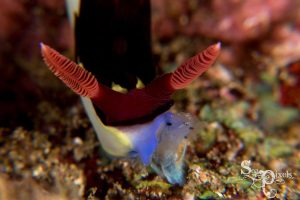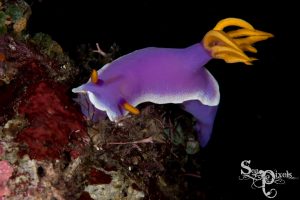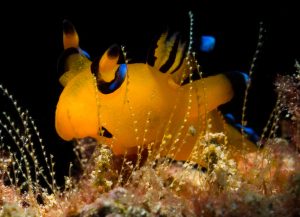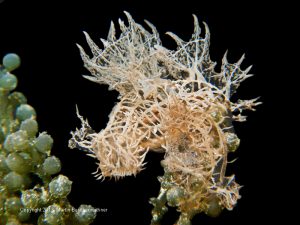 Nudibranchs, also known as sea slugs, are a type of marine mollusk that belong to the class Gastropoda. They are known for their bright colors and unique, often bizarre, shapes and patterns. With over 3,000 known species, nudibranchs can be found in a wide range of marine environments around the world, from shallow coral reefs to deep sea trenches.
One of the most striking features of nudibranchs is their appearance. Many species have vibrant and colorful bodies, which can range from shades of orange, red, and yellow to bright blue, purple, and green. These colors are often used for camouflage or as a form of warning to predators, as many nudibranchs are toxic or distasteful to eat. Some species even have elaborate frills, tentacles, or other appendages that add to their distinctive appearance.
Nudibranchs, also known as sea slugs, are a type of marine mollusk that belong to the class Gastropoda. They are known for their bright colors and unique, often bizarre, shapes and patterns. With over 3,000 known species, nudibranchs can be found in a wide range of marine environments around the world, from shallow coral reefs to deep sea trenches.
One of the most striking features of nudibranchs is their appearance. Many species have vibrant and colorful bodies, which can range from shades of orange, red, and yellow to bright blue, purple, and green. These colors are often used for camouflage or as a form of warning to predators, as many nudibranchs are toxic or distasteful to eat. Some species even have elaborate frills, tentacles, or other appendages that add to their distinctive appearance.
 Despite their small size – most nudibranchs are less than a few inches long – they are highly adaptable and have evolved a number of unique behaviors and characteristics to survive in their environments. Many species are carnivorous, feeding on a variety of prey including sponges, coral, and other invertebrates. Some species have even developed the ability to consume and retain the toxins and stinging cells of their prey, which they can then use as a defense against predators.
Nudibranchs have a unique reproductive system, with both males and females having both male and female reproductive organs. This means that they can either fertilize their own eggs or fertilize the eggs of another individual. Many species lay their eggs in long, spiral-shaped clusters, which can contain hundreds or even thousands of eggs.
Despite their small size – most nudibranchs are less than a few inches long – they are highly adaptable and have evolved a number of unique behaviors and characteristics to survive in their environments. Many species are carnivorous, feeding on a variety of prey including sponges, coral, and other invertebrates. Some species have even developed the ability to consume and retain the toxins and stinging cells of their prey, which they can then use as a defense against predators.
Nudibranchs have a unique reproductive system, with both males and females having both male and female reproductive organs. This means that they can either fertilize their own eggs or fertilize the eggs of another individual. Many species lay their eggs in long, spiral-shaped clusters, which can contain hundreds or even thousands of eggs.
 In addition to their interesting appearance and behaviors, nudibranchs are also important indicators of the health of marine ecosystems. Because they are sensitive to changes in their environment, the presence or absence of certain species can provide valuable information about the overall health of an ecosystem.
In addition to their interesting appearance and behaviors, nudibranchs are also important indicators of the health of marine ecosystems. Because they are sensitive to changes in their environment, the presence or absence of certain species can provide valuable information about the overall health of an ecosystem.
 Despite their importance, nudibranchs are facing a number of threats, including habitat destruction, pollution, and the impacts of climate change. As a result, many species are listed as endangered or threatened, and conservation efforts are underway to protect these fascinating and important animals.
Despite their importance, nudibranchs are facing a number of threats, including habitat destruction, pollution, and the impacts of climate change. As a result, many species are listed as endangered or threatened, and conservation efforts are underway to protect these fascinating and important animals.
 (Photo by : Martin Buschenreithner, with permission. http://slugsite.us/bow2007/nudwk857.htm)
In conclusion, nudibranchs are a diverse and fascinating group of marine mollusks that are known for their bright colors and unique behaviors. From their ability to consume and retain toxins to their complex reproductive system, there is much to learn and appreciate about these amazing creatures. And with their importance as indicators of the health of marine ecosystems, it is crucial that we work to protect and conserve these animals for future generations.
If you're a beginner or professional photographer and interested to take some specific Nudibranch, just drop us an email at Terence@seapixels.org, we will be glad to bring you to them.
(Photo by : Martin Buschenreithner, with permission. http://slugsite.us/bow2007/nudwk857.htm)
In conclusion, nudibranchs are a diverse and fascinating group of marine mollusks that are known for their bright colors and unique behaviors. From their ability to consume and retain toxins to their complex reproductive system, there is much to learn and appreciate about these amazing creatures. And with their importance as indicators of the health of marine ecosystems, it is crucial that we work to protect and conserve these animals for future generations.
If you're a beginner or professional photographer and interested to take some specific Nudibranch, just drop us an email at Terence@seapixels.org, we will be glad to bring you to them.
Nudibranchs, also known as sea slugs, are a type of marine mollusk that belong to the class Gastropoda. They are known for their bright colors and unique, often bizarre, shapes and patterns. With over 3,000 known species, nudibranchs can be found in a wide range of marine environments around the world, from shallow coral reefs to deep sea trenches. One of the most striking features of nudibranchs is their appearance. Many species have vibrant and colorful bodies, which can range from shades of orange, red, and yellow to bright blue, purple, and green. These colors are often used for camouflage or as a form of warning to predators, as many nudibranchs are toxic or distasteful to eat. Some species even have elaborate frills, tentacles, or other appendages that add to their distinctive appearance.
Despite their small size – most nudibranchs are less than a few inches long – they are highly adaptable and have evolved a number of unique behaviors and characteristics to survive in their environments. Many species are carnivorous, feeding on a variety of prey including sponges, coral, and other invertebrates. Some species have even developed the ability to consume and retain the toxins and stinging cells of their prey, which they can then use as a defense against predators. Nudibranchs have a unique reproductive system, with both males and females having both male and female reproductive organs. This means that they can either fertilize their own eggs or fertilize the eggs of another individual. Many species lay their eggs in long, spiral-shaped clusters, which can contain hundreds or even thousands of eggs.
In addition to their interesting appearance and behaviors, nudibranchs are also important indicators of the health of marine ecosystems. Because they are sensitive to changes in their environment, the presence or absence of certain species can provide valuable information about the overall health of an ecosystem.
Despite their importance, nudibranchs are facing a number of threats, including habitat destruction, pollution, and the impacts of climate change. As a result, many species are listed as endangered or threatened, and conservation efforts are underway to protect these fascinating and important animals.
(Photo by : Martin Buschenreithner, with permission. http://slugsite.us/bow2007/nudwk857.htm) In conclusion, nudibranchs are a diverse and fascinating group of marine mollusks that are known for their bright colors and unique behaviors. From their ability to consume and retain toxins to their complex reproductive system, there is much to learn and appreciate about these amazing creatures. And with their importance as indicators of the health of marine ecosystems, it is crucial that we work to protect and conserve these animals for future generations. If you're a beginner or professional photographer and interested to take some specific Nudibranch, just drop us an email at Terence@seapixels.org, we will be glad to bring you to them.